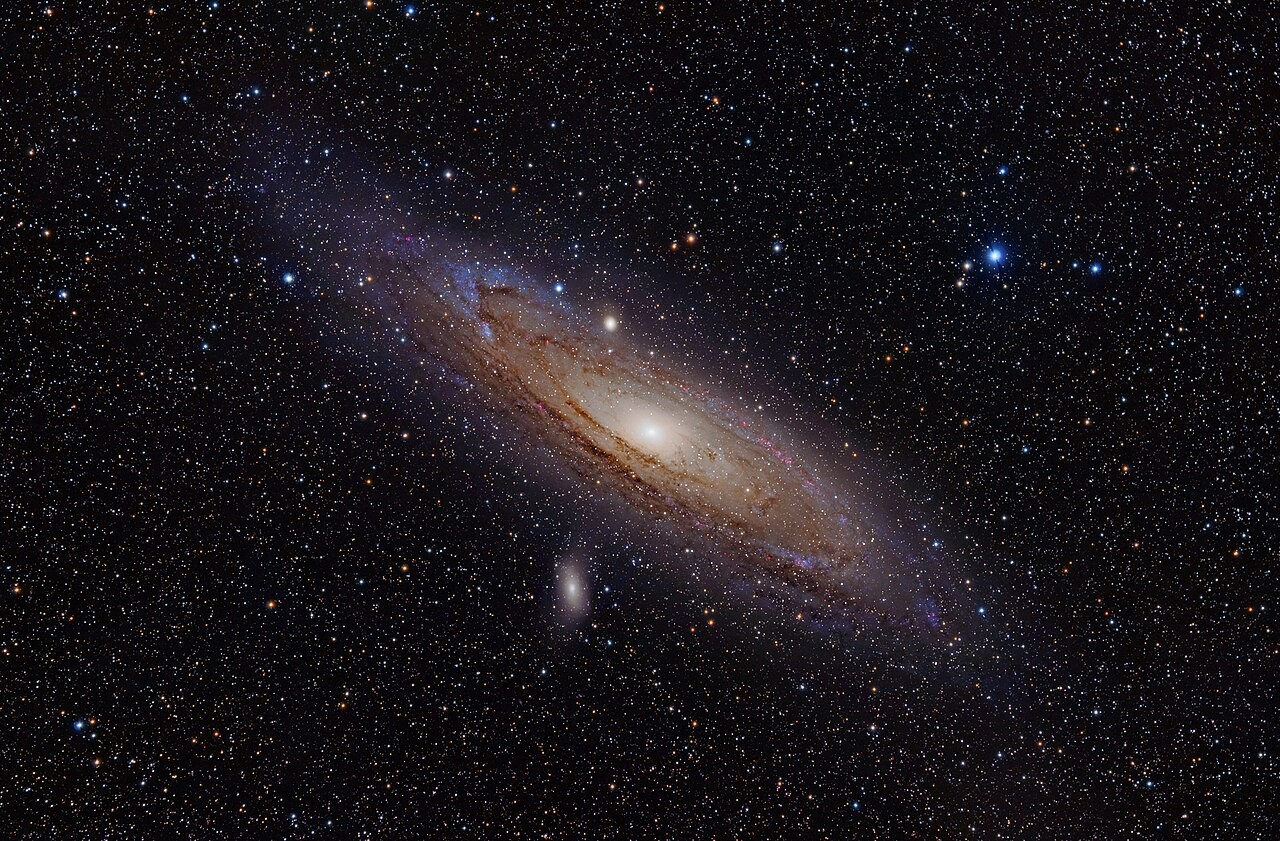The Milky Way’s size is often discussed, but COMPARE.EDU.VN is here to provide a clear comparison of its dimensions relative to other galaxies in the vast universe. Understanding these cosmic scales helps appreciate our place in the cosmos and highlights the diversity of galactic structures, including their size, mass, and composition. Delve into the cosmos and discover how galactic astronomy can provide fascinating revelations about space exploration and the scale of the cosmos.
1. Understanding Galaxies: Building Blocks of the Universe
Before diving into the specifics of the Milky Way’s size compared to other galaxies, it’s important to define what a galaxy actually is. Galaxies are vast, gravitationally bound systems consisting of stars, gas, dust, dark matter, and supermassive black holes at their centers. These celestial islands come in various shapes and sizes, ranging from dwarf galaxies containing just a few million stars to giant ellipticals boasting trillions.
- Elliptical Galaxies: These are characterized by their smooth, featureless appearance and elliptical shape. They are typically composed of older stars and contain little gas and dust.
- Spiral Galaxies: Like our Milky Way, spiral galaxies have a central bulge surrounded by a flattened disk with spiral arms. These arms are regions of active star formation, rich in gas and dust.
- Irregular Galaxies: These galaxies lack a defined shape and often result from gravitational interactions with other galaxies.
An artistic rendering showcases the stunning spiral structure of a distant galaxy.
1.1. The Role of Dark Matter
A significant component of galaxies is dark matter, a mysterious substance that doesn’t interact with light. Although invisible, dark matter’s gravitational effects influence how galaxies rotate and form. Scientists estimate that dark matter makes up about 85% of the total mass of the universe, playing a crucial role in the structure and evolution of galaxies.
2. The Milky Way: Our Galactic Home
The Milky Way is a barred spiral galaxy, characterized by a central bar-shaped structure and spiral arms that emanate from it. It’s home to our solar system and billions of other stars, planets, gas clouds, and dust. Understanding the Milky Way’s size and structure provides a foundation for comparing it to other galaxies.
2.1. Dimensions of the Milky Way
- Diameter: Approximately 100,000 to 180,000 light-years.
- Thickness: About 1,000 light-years in the disk, but much thicker in the central bulge.
- Number of Stars: Estimated to be between 100 to 400 billion.
- Mass: Roughly 1.5 trillion times the mass of the Sun, including dark matter.
A light-year is the distance light travels in one year, approximately 5.88 trillion miles (9.46 trillion kilometers). To put this into perspective, if you could travel at the speed of light, it would take 100,000 to 180,000 years to cross the Milky Way.
2.2. Key Components of the Milky Way
- Central Bulge: A dense region at the center of the galaxy, containing a supermassive black hole called Sagittarius A*.
- Spiral Arms: Regions of active star formation, containing young, hot stars, gas, and dust. The Milky Way has four major spiral arms: Perseus, Orion, Sagittarius, and Centaurus.
- Galactic Disk: The flattened region containing the spiral arms, where most of the galaxy’s stars and gas reside.
- Galactic Halo: A sparse, spherical region surrounding the disk, containing globular clusters (dense collections of old stars) and dark matter.
3. Comparing the Milky Way to Other Galaxies: Size Matters
The Milky Way is considered a fairly large galaxy, but it’s not the largest in the universe. Comparing it to other galaxies reveals a wide range of sizes and characteristics.
3.1. Andromeda Galaxy (M31)
Andromeda is the Milky Way’s largest galactic neighbor and a member of the Local Group, a cluster of galaxies that includes our own.
- Diameter: Approximately 220,000 light-years.
- Number of Stars: Estimated to be around 1 trillion.
- Distance from the Milky Way: About 2.5 million light-years.
Andromeda is larger and more massive than the Milky Way, containing roughly twice as many stars. In about 4.5 billion years, the Milky Way and Andromeda are predicted to collide, eventually merging into a giant elliptical galaxy.
3.2. Triangulum Galaxy (M33)
The Triangulum Galaxy is another member of the Local Group, smaller than both the Milky Way and Andromeda.
- Diameter: About 50,000 to 60,000 light-years.
- Number of Stars: Estimated to be around 40 billion.
- Distance from the Milky Way: Approximately 3 million light-years.
Triangulum is a spiral galaxy with a less defined structure than the Milky Way or Andromeda. It’s actively forming stars and contains a significant amount of gas and dust.
3.3. Large Magellanic Cloud (LMC) and Small Magellanic Cloud (SMC)
These are dwarf galaxies that are satellites of the Milky Way, gravitationally bound to our galaxy.
- Large Magellanic Cloud (LMC):
- Diameter: About 14,000 light-years.
- Number of Stars: Estimated to be around 30 billion.
- Distance from the Milky Way: Approximately 160,000 light-years.
- Small Magellanic Cloud (SMC):
- Diameter: About 7,000 light-years.
- Number of Stars: Estimated to be around 3 billion.
- Distance from the Milky Way: Approximately 200,000 light-years.
The LMC and SMC are irregular galaxies that have been distorted by their gravitational interactions with the Milky Way. They are actively forming stars and are important laboratories for studying stellar evolution.
3.4. IC 1101: A Supergiant Galaxy
IC 1101 is one of the largest known galaxies in the observable universe, a supergiant elliptical galaxy located about 1 billion light-years away.
- Diameter: Approximately 4 million light-years.
- Number of Stars: Estimated to be around 100 trillion.
IC 1101 is much larger and more massive than the Milky Way. If the Milky Way were placed at the center of IC 1101, it would be just a small speck within this colossal galaxy.
3.5. M87: A Giant Elliptical Galaxy
M87 is another giant elliptical galaxy, located in the Virgo Cluster, about 53.5 million light-years away. It is known for its supermassive black hole, which was the first black hole to be directly imaged by the Event Horizon Telescope.
- Diameter: Approximately 120,000 light-years.
- Number of Stars: Estimated to be in the trillions.
While its diameter is similar to the Milky Way, M87 is far more massive due to its high concentration of stars and supermassive black hole.
4. Factors Influencing Galaxy Size
Several factors contribute to the size and mass of a galaxy, including:
- Mergers: Galaxies can grow by merging with other galaxies. When two galaxies collide, their stars, gas, and dust mix, forming a larger, more massive galaxy.
- Accretion: Galaxies can also grow by accreting gas and dust from their surroundings. This material provides the raw ingredients for star formation, increasing the galaxy’s size and mass.
- Dark Matter Halos: The amount of dark matter surrounding a galaxy plays a crucial role in its formation and evolution. Larger dark matter halos can attract more gas and dust, leading to the formation of larger galaxies.
- Star Formation Rate: The rate at which stars are born in a galaxy affects its size and appearance. Galaxies with high star formation rates tend to be brighter and bluer, while those with low star formation rates are redder and fainter.
A stunning depiction of two galaxies colliding, a process that can significantly alter their size and structure.
5. The Significance of Galactic Size Comparisons
Comparing the sizes of galaxies is not just an academic exercise. It provides valuable insights into:
- Galaxy Evolution: Understanding how galaxies grow and evolve over time, including the role of mergers, accretion, and star formation.
- Cosmology: Testing cosmological models and understanding the distribution of matter in the universe.
- Our Place in the Universe: Appreciating the scale of the cosmos and our place within it.
- Astrobiology: Understanding the conditions that might be conducive to life in other galaxies.
6. Visualizing Galactic Sizes
To better understand the vast differences in galactic sizes, consider the following analogies:
- If the Milky Way were the size of a dinner plate, Andromeda would be slightly larger than another dinner plate, placed about 6 feet away.
- The Large Magellanic Cloud would be about the size of a dime, orbiting the dinner plate Milky Way.
- IC 1101, the supergiant galaxy, would be as large as a small car, dwarfing the dinner plate Milky Way.
These analogies help illustrate the enormous range in sizes among galaxies.
7. The Future of Galactic Research
Astronomers continue to study galaxies using telescopes and computer simulations to learn more about their formation, evolution, and composition. Future research will focus on:
- Mapping the Distribution of Dark Matter: Understanding the role of dark matter in galaxy formation and evolution.
- Studying Galaxy Mergers: Observing and simulating galaxy mergers to understand how they affect galaxy size and structure.
- Searching for Habitable Planets: Identifying galaxies with conditions that might be conducive to the formation of habitable planets.
- Exploring the Most Distant Galaxies: Studying galaxies at the edge of the observable universe to understand the early stages of galaxy formation.
8. The Dynamic Nature of Galaxies
Galaxies are not static objects; they are constantly changing and evolving. Stars are born and die, gas clouds collapse and form new stars, and galaxies collide and merge. These dynamic processes shape the appearance and size of galaxies over billions of years.
8.1. Star Formation in Galaxies
Star formation is a fundamental process in galaxies, converting gas and dust into new stars. The rate of star formation varies widely among galaxies, with some galaxies forming stars at a rapid pace (starburst galaxies) and others forming stars very slowly.
8.2. Supermassive Black Holes
Most, if not all, large galaxies host supermassive black holes at their centers. These black holes can have masses millions or even billions of times the mass of the Sun. They play a crucial role in regulating the growth and evolution of galaxies by influencing the gas and star formation in their vicinity.
9. Implications for Understanding the Universe
The study of galaxies is essential for understanding the universe as a whole. By studying the distribution, size, and composition of galaxies, astronomers can test cosmological models and learn about the fundamental laws of physics.
9.1. The Expanding Universe
The observation that galaxies are moving away from each other is one of the key pieces of evidence for the expanding universe. By measuring the distances and velocities of galaxies, astronomers can determine the rate at which the universe is expanding.
9.2. The Cosmic Microwave Background
The cosmic microwave background (CMB) is the afterglow of the Big Bang, the event that marked the beginning of the universe. By studying the CMB, astronomers can learn about the conditions in the early universe and the formation of the first galaxies.
10. Frequently Asked Questions (FAQ)
-
How is the size of a galaxy measured?
The size of a galaxy is typically measured by determining its diameter, the distance across its longest axis. Astronomers use telescopes to observe the galaxy and measure the angular size on the sky. Knowing the distance to the galaxy, they can then calculate its physical size using trigonometry.
-
What is the largest known galaxy in the universe?
IC 1101 is one of the largest known galaxies, with a diameter of approximately 4 million light-years.
-
How many galaxies are there in the observable universe?
Estimates suggest there are about 2 trillion galaxies in the observable universe.
-
What is the Milky Way’s place in the Local Group?
The Milky Way is one of the largest members of the Local Group, a cluster of galaxies that includes Andromeda, Triangulum, and several dwarf galaxies.
-
What will happen when the Milky Way and Andromeda collide?
In about 4.5 billion years, the Milky Way and Andromeda are predicted to collide and merge into a giant elliptical galaxy, sometimes referred to as “Milkomeda.”
-
How do galaxies form?
Galaxies are believed to form from the gravitational collapse of overdense regions in the early universe. Dark matter plays a crucial role in this process, providing the gravitational scaffolding for galaxies to form.
-
What is the role of supermassive black holes in galaxies?
Supermassive black holes are thought to exist at the centers of most large galaxies. They influence the growth and evolution of their host galaxies by regulating star formation and driving powerful outflows of gas and energy.
-
How do astronomers study galaxies?
Astronomers use a variety of telescopes and techniques to study galaxies, including optical, radio, infrared, and X-ray observations. They also use computer simulations to model galaxy formation and evolution.
-
Can galaxies change their type over time?
Yes, galaxies can change their type over time, for example, through mergers or interactions with other galaxies. Spiral galaxies can transform into elliptical galaxies through mergers.
-
What are the main types of galaxies?
The main types of galaxies are elliptical, spiral, and irregular.
11. Conclusion: The Vastness of the Cosmos
Comparing the size of the Milky Way to other galaxies highlights the vastness and diversity of the cosmos. While the Milky Way is a substantial galaxy, it’s just one of trillions of galaxies in the observable universe, each with its own unique characteristics and history. Understanding these galactic scales helps us appreciate our place in the universe and inspires further exploration and discovery.
Need more detailed comparisons to make informed decisions? Visit COMPARE.EDU.VN today for comprehensive analyses and comparisons across various topics.
Contact Information:
Address: 333 Comparison Plaza, Choice City, CA 90210, United States
Whatsapp: +1 (626) 555-9090
Website: compare.edu.vn


